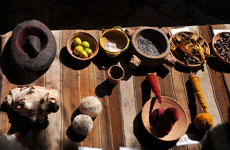
The two cornerstones of Peruvian art are the pre-Columbian traditions and Spanish influence. Whereas many pre-Columbian traditions are still preserved today, especially (on) in the countryside, the Spanish colonization left a very strong imprint. The vast missionary operation of the conquistadors gave birth to a mix of native beliefs and Catholicism. This religious ambiguity is tangible in Peruvian art. Today, 90 % of the population is catholic, but part of the Andean belief still lives on in daily customs. Painting: The historical epicentre of Peruvian, and even South American painting and folk art, lies in Cusco. The city developed a distinctive style of painting known as the "Cusco School” since the late 16th century. Locals were taught painting techniques by Spanish settlers, as a way of professing catholic religion through imagery. They therefore imposed strictly religious themes with a missionary purpose. Little by little, the indigenous artists started to add more and more traditional Andean themes, like local animals or types of clothing. A new style was born.
|
